ACC213 Case Study: Legal and Ethical Issues in News Reporting
VerifiedAdded on 2022/08/01
|11
|2642
|18
Case Study
AI Summary
This case study examines legal and ethical issues in media, focusing on a murder investigation and its coverage by news outlets and social media. It explores the ethical responsibilities of journalists, the police, and social media platforms, highlighting violations of privacy, inaccurate reporting, and breaches of codes of conduct. The analysis covers the delivery of news by police and news channels, the unethical behavior of social media, ethical considerations after the recovery of the victim's body, and the ethical and legal issues arising from court proceedings. The study references various ethical codes and media laws, including those of the Commercial Television Industry, Commercial Radio, and the Journalist Code of Ethics. The case underscores the importance of accuracy, fairness, and respect for privacy in media reporting, and the potential consequences of unethical practices.
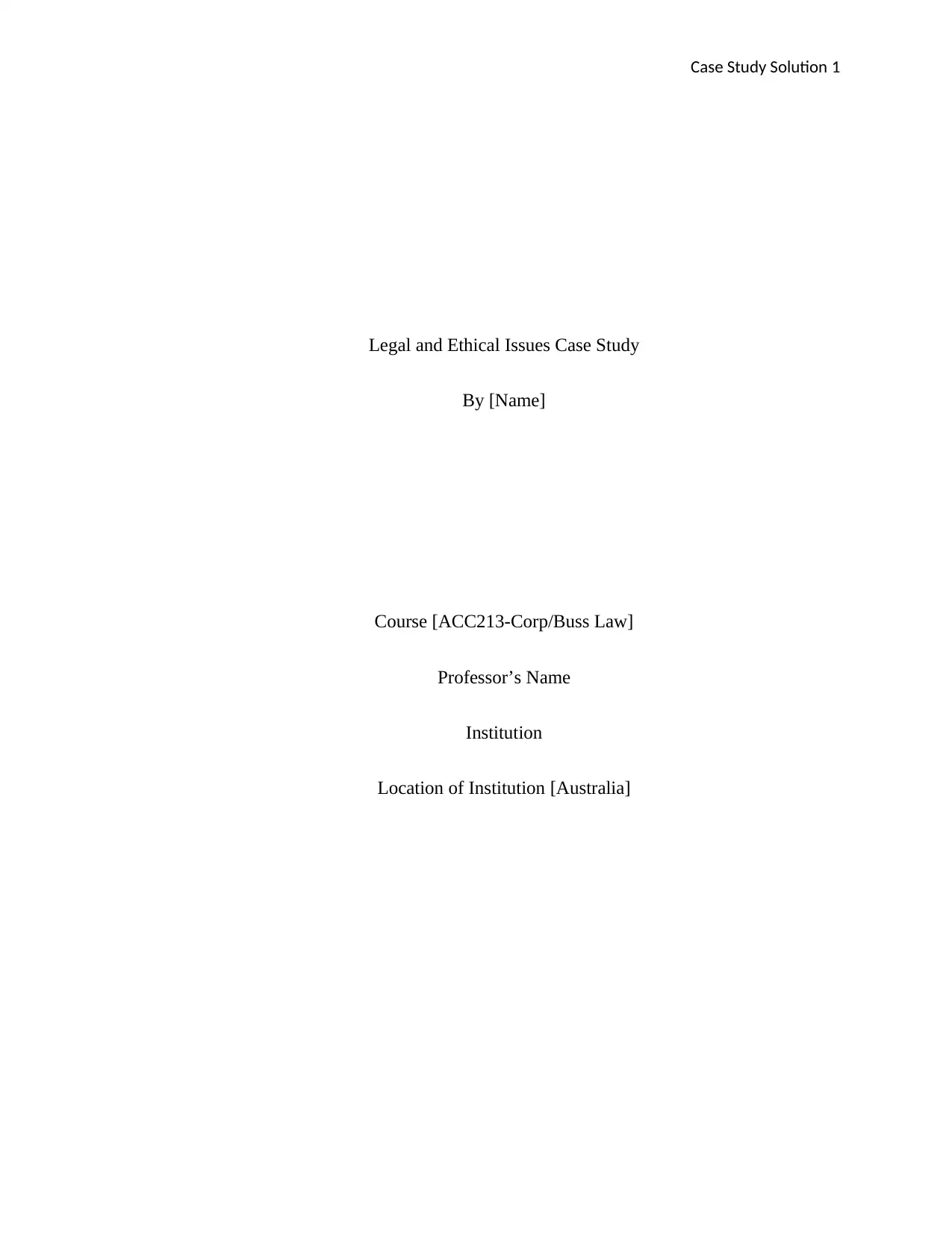
Case Study Solution 1
Legal and Ethical Issues Case Study
By [Name]
Course [ACC213-Corp/Buss Law]
Professor’s Name
Institution
Location of Institution [Australia]
Legal and Ethical Issues Case Study
By [Name]
Course [ACC213-Corp/Buss Law]
Professor’s Name
Institution
Location of Institution [Australia]
Paraphrase This Document
Need a fresh take? Get an instant paraphrase of this document with our AI Paraphraser
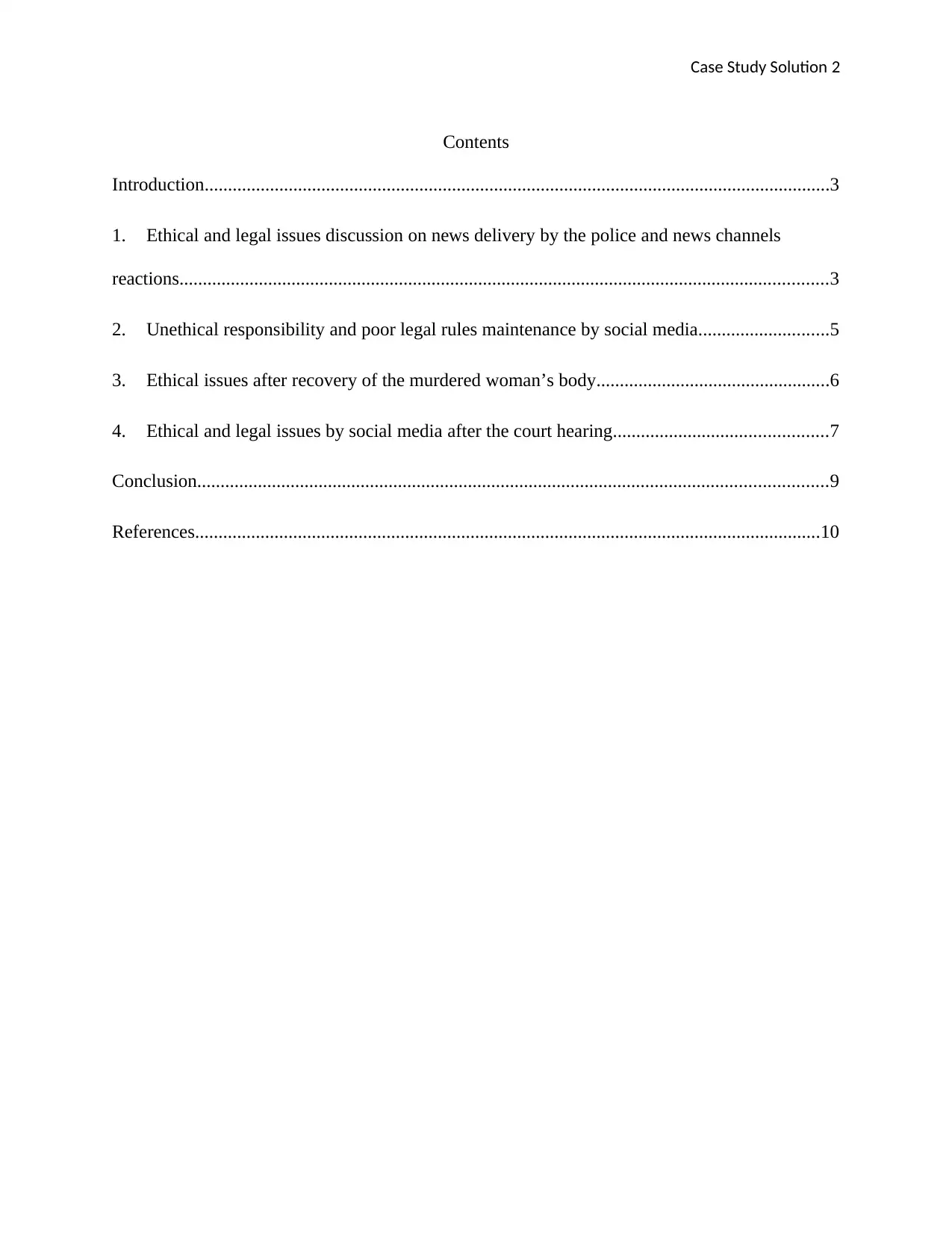
Case Study Solution 2
Contents
Introduction......................................................................................................................................3
1. Ethical and legal issues discussion on news delivery by the police and news channels
reactions...........................................................................................................................................3
2. Unethical responsibility and poor legal rules maintenance by social media............................5
3. Ethical issues after recovery of the murdered woman’s body..................................................6
4. Ethical and legal issues by social media after the court hearing..............................................7
Conclusion.......................................................................................................................................9
References......................................................................................................................................10
Contents
Introduction......................................................................................................................................3
1. Ethical and legal issues discussion on news delivery by the police and news channels
reactions...........................................................................................................................................3
2. Unethical responsibility and poor legal rules maintenance by social media............................5
3. Ethical issues after recovery of the murdered woman’s body..................................................6
4. Ethical and legal issues by social media after the court hearing..............................................7
Conclusion.......................................................................................................................................9
References......................................................................................................................................10
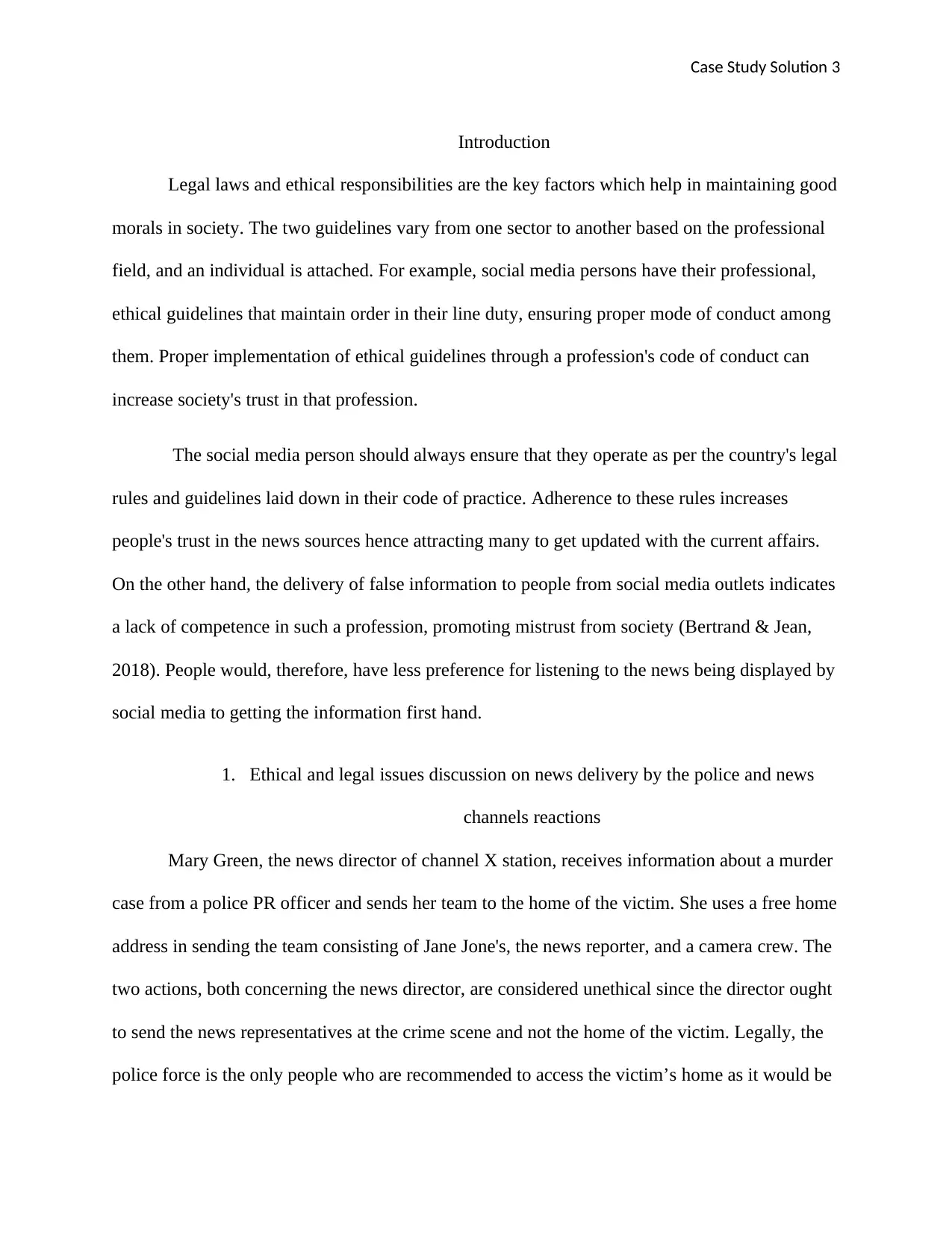
Case Study Solution 3
Introduction
Legal laws and ethical responsibilities are the key factors which help in maintaining good
morals in society. The two guidelines vary from one sector to another based on the professional
field, and an individual is attached. For example, social media persons have their professional,
ethical guidelines that maintain order in their line duty, ensuring proper mode of conduct among
them. Proper implementation of ethical guidelines through a profession's code of conduct can
increase society's trust in that profession.
The social media person should always ensure that they operate as per the country's legal
rules and guidelines laid down in their code of practice. Adherence to these rules increases
people's trust in the news sources hence attracting many to get updated with the current affairs.
On the other hand, the delivery of false information to people from social media outlets indicates
a lack of competence in such a profession, promoting mistrust from society (Bertrand & Jean,
2018). People would, therefore, have less preference for listening to the news being displayed by
social media to getting the information first hand.
1. Ethical and legal issues discussion on news delivery by the police and news
channels reactions
Mary Green, the news director of channel X station, receives information about a murder
case from a police PR officer and sends her team to the home of the victim. She uses a free home
address in sending the team consisting of Jane Jone's, the news reporter, and a camera crew. The
two actions, both concerning the news director, are considered unethical since the director ought
to send the news representatives at the crime scene and not the home of the victim. Legally, the
police force is the only people who are recommended to access the victim’s home as it would be
Introduction
Legal laws and ethical responsibilities are the key factors which help in maintaining good
morals in society. The two guidelines vary from one sector to another based on the professional
field, and an individual is attached. For example, social media persons have their professional,
ethical guidelines that maintain order in their line duty, ensuring proper mode of conduct among
them. Proper implementation of ethical guidelines through a profession's code of conduct can
increase society's trust in that profession.
The social media person should always ensure that they operate as per the country's legal
rules and guidelines laid down in their code of practice. Adherence to these rules increases
people's trust in the news sources hence attracting many to get updated with the current affairs.
On the other hand, the delivery of false information to people from social media outlets indicates
a lack of competence in such a profession, promoting mistrust from society (Bertrand & Jean,
2018). People would, therefore, have less preference for listening to the news being displayed by
social media to getting the information first hand.
1. Ethical and legal issues discussion on news delivery by the police and news
channels reactions
Mary Green, the news director of channel X station, receives information about a murder
case from a police PR officer and sends her team to the home of the victim. She uses a free home
address in sending the team consisting of Jane Jone's, the news reporter, and a camera crew. The
two actions, both concerning the news director, are considered unethical since the director ought
to send the news representatives at the crime scene and not the home of the victim. Legally, the
police force is the only people who are recommended to access the victim’s home as it would be
⊘ This is a preview!⊘
Do you want full access?
Subscribe today to unlock all pages.

Trusted by 1+ million students worldwide
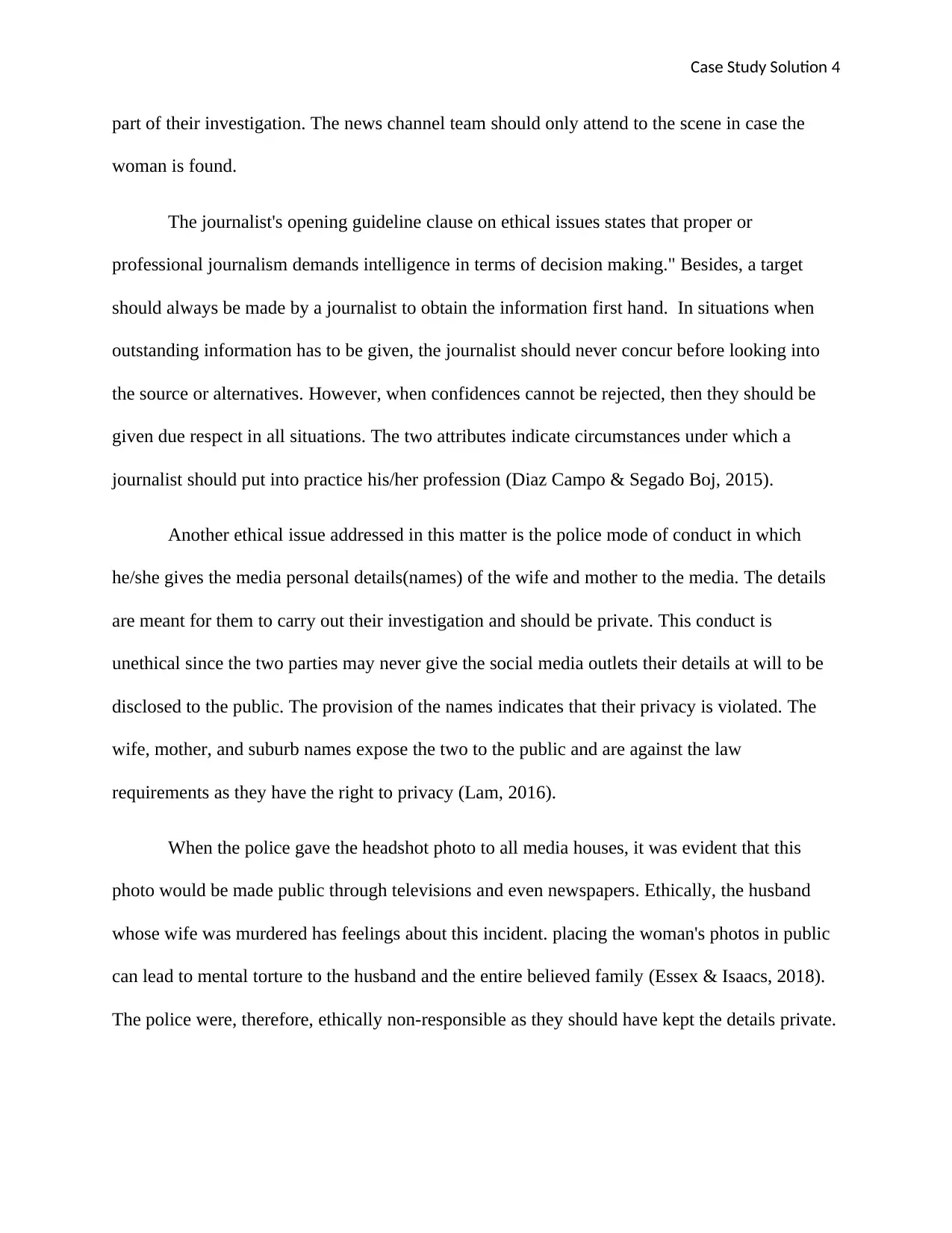
Case Study Solution 4
part of their investigation. The news channel team should only attend to the scene in case the
woman is found.
The journalist's opening guideline clause on ethical issues states that proper or
professional journalism demands intelligence in terms of decision making." Besides, a target
should always be made by a journalist to obtain the information first hand. In situations when
outstanding information has to be given, the journalist should never concur before looking into
the source or alternatives. However, when confidences cannot be rejected, then they should be
given due respect in all situations. The two attributes indicate circumstances under which a
journalist should put into practice his/her profession (Diaz Campo & Segado Boj, 2015).
Another ethical issue addressed in this matter is the police mode of conduct in which
he/she gives the media personal details(names) of the wife and mother to the media. The details
are meant for them to carry out their investigation and should be private. This conduct is
unethical since the two parties may never give the social media outlets their details at will to be
disclosed to the public. The provision of the names indicates that their privacy is violated. The
wife, mother, and suburb names expose the two to the public and are against the law
requirements as they have the right to privacy (Lam, 2016).
When the police gave the headshot photo to all media houses, it was evident that this
photo would be made public through televisions and even newspapers. Ethically, the husband
whose wife was murdered has feelings about this incident. placing the woman's photos in public
can lead to mental torture to the husband and the entire believed family (Essex & Isaacs, 2018).
The police were, therefore, ethically non-responsible as they should have kept the details private.
part of their investigation. The news channel team should only attend to the scene in case the
woman is found.
The journalist's opening guideline clause on ethical issues states that proper or
professional journalism demands intelligence in terms of decision making." Besides, a target
should always be made by a journalist to obtain the information first hand. In situations when
outstanding information has to be given, the journalist should never concur before looking into
the source or alternatives. However, when confidences cannot be rejected, then they should be
given due respect in all situations. The two attributes indicate circumstances under which a
journalist should put into practice his/her profession (Diaz Campo & Segado Boj, 2015).
Another ethical issue addressed in this matter is the police mode of conduct in which
he/she gives the media personal details(names) of the wife and mother to the media. The details
are meant for them to carry out their investigation and should be private. This conduct is
unethical since the two parties may never give the social media outlets their details at will to be
disclosed to the public. The provision of the names indicates that their privacy is violated. The
wife, mother, and suburb names expose the two to the public and are against the law
requirements as they have the right to privacy (Lam, 2016).
When the police gave the headshot photo to all media houses, it was evident that this
photo would be made public through televisions and even newspapers. Ethically, the husband
whose wife was murdered has feelings about this incident. placing the woman's photos in public
can lead to mental torture to the husband and the entire believed family (Essex & Isaacs, 2018).
The police were, therefore, ethically non-responsible as they should have kept the details private.
Paraphrase This Document
Need a fresh take? Get an instant paraphrase of this document with our AI Paraphraser
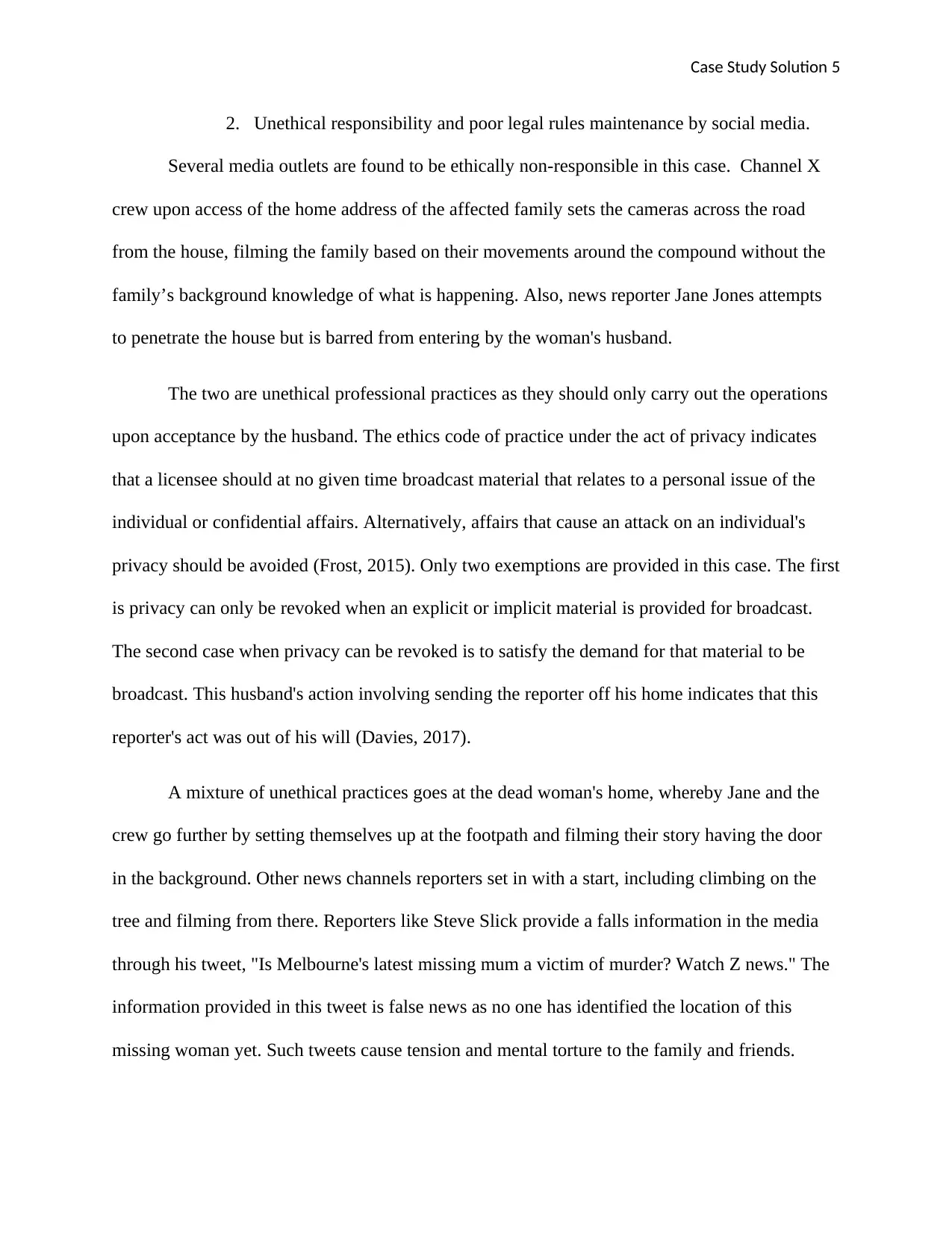
Case Study Solution 5
2. Unethical responsibility and poor legal rules maintenance by social media.
Several media outlets are found to be ethically non-responsible in this case. Channel X
crew upon access of the home address of the affected family sets the cameras across the road
from the house, filming the family based on their movements around the compound without the
family’s background knowledge of what is happening. Also, news reporter Jane Jones attempts
to penetrate the house but is barred from entering by the woman's husband.
The two are unethical professional practices as they should only carry out the operations
upon acceptance by the husband. The ethics code of practice under the act of privacy indicates
that a licensee should at no given time broadcast material that relates to a personal issue of the
individual or confidential affairs. Alternatively, affairs that cause an attack on an individual's
privacy should be avoided (Frost, 2015). Only two exemptions are provided in this case. The first
is privacy can only be revoked when an explicit or implicit material is provided for broadcast.
The second case when privacy can be revoked is to satisfy the demand for that material to be
broadcast. This husband's action involving sending the reporter off his home indicates that this
reporter's act was out of his will (Davies, 2017).
A mixture of unethical practices goes at the dead woman's home, whereby Jane and the
crew go further by setting themselves up at the footpath and filming their story having the door
in the background. Other news channels reporters set in with a start, including climbing on the
tree and filming from there. Reporters like Steve Slick provide a falls information in the media
through his tweet, "Is Melbourne's latest missing mum a victim of murder? Watch Z news." The
information provided in this tweet is false news as no one has identified the location of this
missing woman yet. Such tweets cause tension and mental torture to the family and friends.
2. Unethical responsibility and poor legal rules maintenance by social media.
Several media outlets are found to be ethically non-responsible in this case. Channel X
crew upon access of the home address of the affected family sets the cameras across the road
from the house, filming the family based on their movements around the compound without the
family’s background knowledge of what is happening. Also, news reporter Jane Jones attempts
to penetrate the house but is barred from entering by the woman's husband.
The two are unethical professional practices as they should only carry out the operations
upon acceptance by the husband. The ethics code of practice under the act of privacy indicates
that a licensee should at no given time broadcast material that relates to a personal issue of the
individual or confidential affairs. Alternatively, affairs that cause an attack on an individual's
privacy should be avoided (Frost, 2015). Only two exemptions are provided in this case. The first
is privacy can only be revoked when an explicit or implicit material is provided for broadcast.
The second case when privacy can be revoked is to satisfy the demand for that material to be
broadcast. This husband's action involving sending the reporter off his home indicates that this
reporter's act was out of his will (Davies, 2017).
A mixture of unethical practices goes at the dead woman's home, whereby Jane and the
crew go further by setting themselves up at the footpath and filming their story having the door
in the background. Other news channels reporters set in with a start, including climbing on the
tree and filming from there. Reporters like Steve Slick provide a falls information in the media
through his tweet, "Is Melbourne's latest missing mum a victim of murder? Watch Z news." The
information provided in this tweet is false news as no one has identified the location of this
missing woman yet. Such tweets cause tension and mental torture to the family and friends.
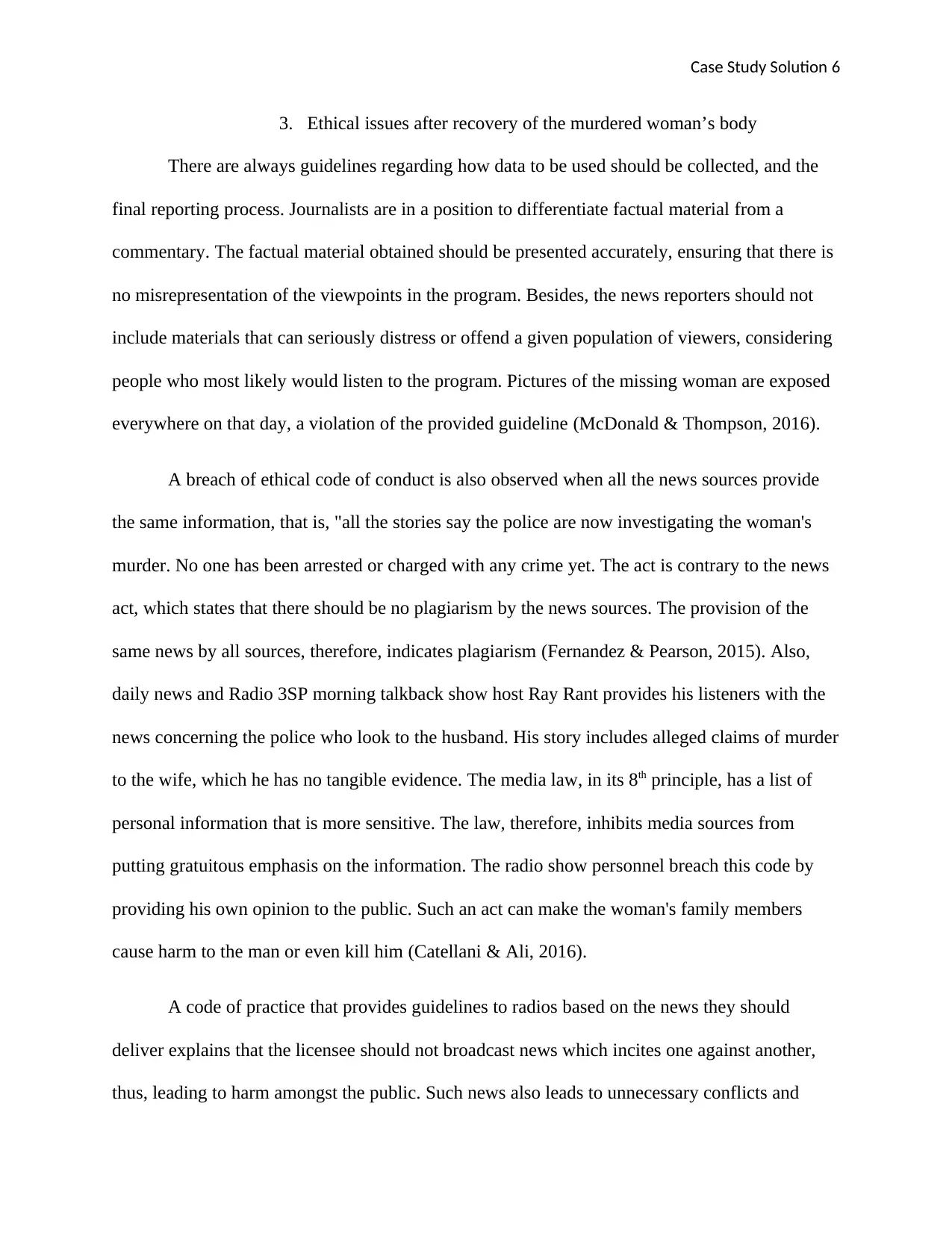
Case Study Solution 6
3. Ethical issues after recovery of the murdered woman’s body
There are always guidelines regarding how data to be used should be collected, and the
final reporting process. Journalists are in a position to differentiate factual material from a
commentary. The factual material obtained should be presented accurately, ensuring that there is
no misrepresentation of the viewpoints in the program. Besides, the news reporters should not
include materials that can seriously distress or offend a given population of viewers, considering
people who most likely would listen to the program. Pictures of the missing woman are exposed
everywhere on that day, a violation of the provided guideline (McDonald & Thompson, 2016).
A breach of ethical code of conduct is also observed when all the news sources provide
the same information, that is, "all the stories say the police are now investigating the woman's
murder. No one has been arrested or charged with any crime yet. The act is contrary to the news
act, which states that there should be no plagiarism by the news sources. The provision of the
same news by all sources, therefore, indicates plagiarism (Fernandez & Pearson, 2015). Also,
daily news and Radio 3SP morning talkback show host Ray Rant provides his listeners with the
news concerning the police who look to the husband. His story includes alleged claims of murder
to the wife, which he has no tangible evidence. The media law, in its 8th principle, has a list of
personal information that is more sensitive. The law, therefore, inhibits media sources from
putting gratuitous emphasis on the information. The radio show personnel breach this code by
providing his own opinion to the public. Such an act can make the woman's family members
cause harm to the man or even kill him (Catellani & Ali, 2016).
A code of practice that provides guidelines to radios based on the news they should
deliver explains that the licensee should not broadcast news which incites one against another,
thus, leading to harm amongst the public. Such news also leads to unnecessary conflicts and
3. Ethical issues after recovery of the murdered woman’s body
There are always guidelines regarding how data to be used should be collected, and the
final reporting process. Journalists are in a position to differentiate factual material from a
commentary. The factual material obtained should be presented accurately, ensuring that there is
no misrepresentation of the viewpoints in the program. Besides, the news reporters should not
include materials that can seriously distress or offend a given population of viewers, considering
people who most likely would listen to the program. Pictures of the missing woman are exposed
everywhere on that day, a violation of the provided guideline (McDonald & Thompson, 2016).
A breach of ethical code of conduct is also observed when all the news sources provide
the same information, that is, "all the stories say the police are now investigating the woman's
murder. No one has been arrested or charged with any crime yet. The act is contrary to the news
act, which states that there should be no plagiarism by the news sources. The provision of the
same news by all sources, therefore, indicates plagiarism (Fernandez & Pearson, 2015). Also,
daily news and Radio 3SP morning talkback show host Ray Rant provides his listeners with the
news concerning the police who look to the husband. His story includes alleged claims of murder
to the wife, which he has no tangible evidence. The media law, in its 8th principle, has a list of
personal information that is more sensitive. The law, therefore, inhibits media sources from
putting gratuitous emphasis on the information. The radio show personnel breach this code by
providing his own opinion to the public. Such an act can make the woman's family members
cause harm to the man or even kill him (Catellani & Ali, 2016).
A code of practice that provides guidelines to radios based on the news they should
deliver explains that the licensee should not broadcast news which incites one against another,
thus, leading to harm amongst the public. Such news also leads to unnecessary conflicts and
⊘ This is a preview!⊘
Do you want full access?
Subscribe today to unlock all pages.

Trusted by 1+ million students worldwide
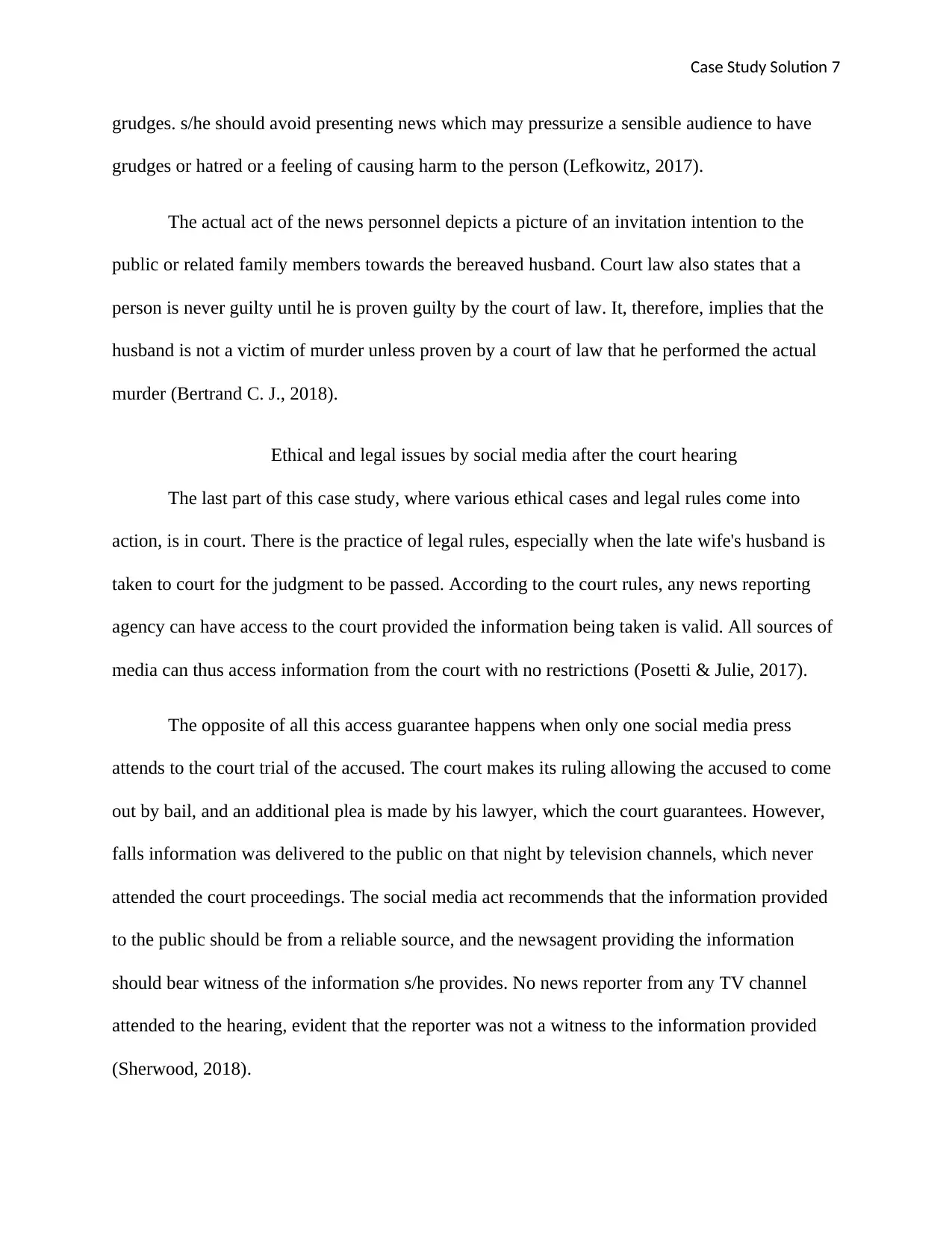
Case Study Solution 7
grudges. s/he should avoid presenting news which may pressurize a sensible audience to have
grudges or hatred or a feeling of causing harm to the person (Lefkowitz, 2017).
The actual act of the news personnel depicts a picture of an invitation intention to the
public or related family members towards the bereaved husband. Court law also states that a
person is never guilty until he is proven guilty by the court of law. It, therefore, implies that the
husband is not a victim of murder unless proven by a court of law that he performed the actual
murder (Bertrand C. J., 2018).
Ethical and legal issues by social media after the court hearing
The last part of this case study, where various ethical cases and legal rules come into
action, is in court. There is the practice of legal rules, especially when the late wife's husband is
taken to court for the judgment to be passed. According to the court rules, any news reporting
agency can have access to the court provided the information being taken is valid. All sources of
media can thus access information from the court with no restrictions (Posetti & Julie, 2017).
The opposite of all this access guarantee happens when only one social media press
attends to the court trial of the accused. The court makes its ruling allowing the accused to come
out by bail, and an additional plea is made by his lawyer, which the court guarantees. However,
falls information was delivered to the public on that night by television channels, which never
attended the court proceedings. The social media act recommends that the information provided
to the public should be from a reliable source, and the newsagent providing the information
should bear witness of the information s/he provides. No news reporter from any TV channel
attended to the hearing, evident that the reporter was not a witness to the information provided
(Sherwood, 2018).
grudges. s/he should avoid presenting news which may pressurize a sensible audience to have
grudges or hatred or a feeling of causing harm to the person (Lefkowitz, 2017).
The actual act of the news personnel depicts a picture of an invitation intention to the
public or related family members towards the bereaved husband. Court law also states that a
person is never guilty until he is proven guilty by the court of law. It, therefore, implies that the
husband is not a victim of murder unless proven by a court of law that he performed the actual
murder (Bertrand C. J., 2018).
Ethical and legal issues by social media after the court hearing
The last part of this case study, where various ethical cases and legal rules come into
action, is in court. There is the practice of legal rules, especially when the late wife's husband is
taken to court for the judgment to be passed. According to the court rules, any news reporting
agency can have access to the court provided the information being taken is valid. All sources of
media can thus access information from the court with no restrictions (Posetti & Julie, 2017).
The opposite of all this access guarantee happens when only one social media press
attends to the court trial of the accused. The court makes its ruling allowing the accused to come
out by bail, and an additional plea is made by his lawyer, which the court guarantees. However,
falls information was delivered to the public on that night by television channels, which never
attended the court proceedings. The social media act recommends that the information provided
to the public should be from a reliable source, and the newsagent providing the information
should bear witness of the information s/he provides. No news reporter from any TV channel
attended to the hearing, evident that the reporter was not a witness to the information provided
(Sherwood, 2018).
Paraphrase This Document
Need a fresh take? Get an instant paraphrase of this document with our AI Paraphraser
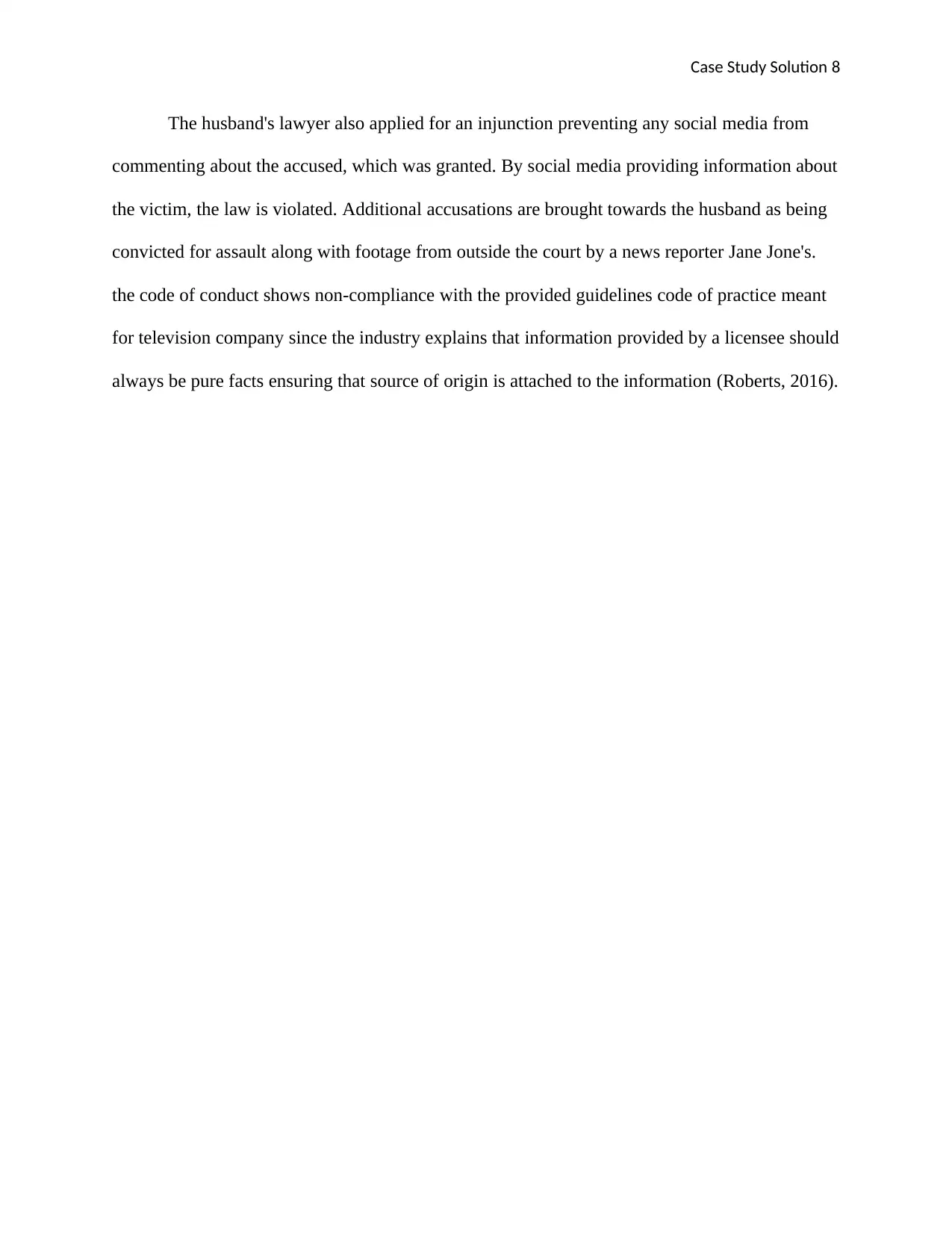
Case Study Solution 8
The husband's lawyer also applied for an injunction preventing any social media from
commenting about the accused, which was granted. By social media providing information about
the victim, the law is violated. Additional accusations are brought towards the husband as being
convicted for assault along with footage from outside the court by a news reporter Jane Jone's.
the code of conduct shows non-compliance with the provided guidelines code of practice meant
for television company since the industry explains that information provided by a licensee should
always be pure facts ensuring that source of origin is attached to the information (Roberts, 2016).
The husband's lawyer also applied for an injunction preventing any social media from
commenting about the accused, which was granted. By social media providing information about
the victim, the law is violated. Additional accusations are brought towards the husband as being
convicted for assault along with footage from outside the court by a news reporter Jane Jone's.
the code of conduct shows non-compliance with the provided guidelines code of practice meant
for television company since the industry explains that information provided by a licensee should
always be pure facts ensuring that source of origin is attached to the information (Roberts, 2016).
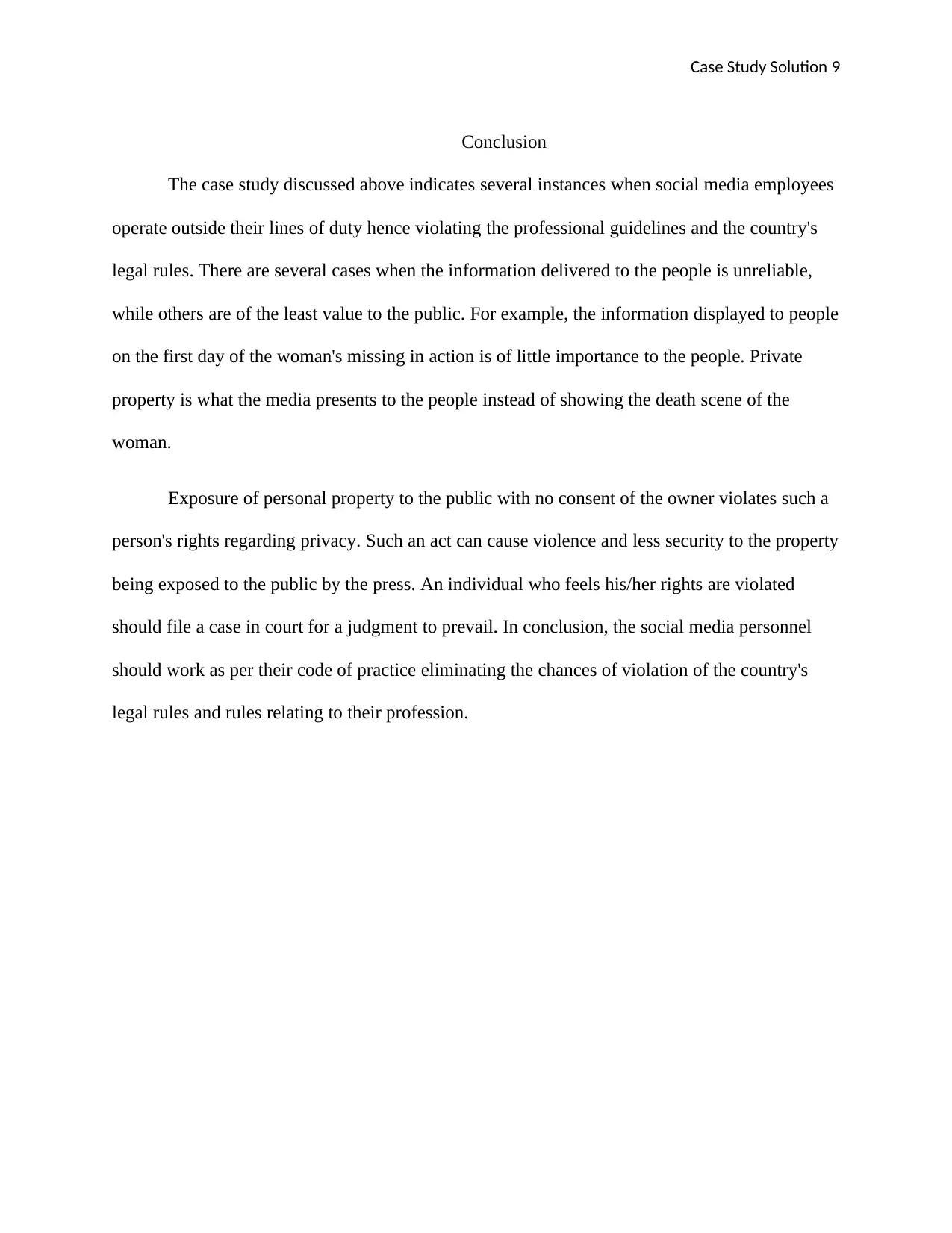
Case Study Solution 9
Conclusion
The case study discussed above indicates several instances when social media employees
operate outside their lines of duty hence violating the professional guidelines and the country's
legal rules. There are several cases when the information delivered to the people is unreliable,
while others are of the least value to the public. For example, the information displayed to people
on the first day of the woman's missing in action is of little importance to the people. Private
property is what the media presents to the people instead of showing the death scene of the
woman.
Exposure of personal property to the public with no consent of the owner violates such a
person's rights regarding privacy. Such an act can cause violence and less security to the property
being exposed to the public by the press. An individual who feels his/her rights are violated
should file a case in court for a judgment to prevail. In conclusion, the social media personnel
should work as per their code of practice eliminating the chances of violation of the country's
legal rules and rules relating to their profession.
Conclusion
The case study discussed above indicates several instances when social media employees
operate outside their lines of duty hence violating the professional guidelines and the country's
legal rules. There are several cases when the information delivered to the people is unreliable,
while others are of the least value to the public. For example, the information displayed to people
on the first day of the woman's missing in action is of little importance to the people. Private
property is what the media presents to the people instead of showing the death scene of the
woman.
Exposure of personal property to the public with no consent of the owner violates such a
person's rights regarding privacy. Such an act can cause violence and less security to the property
being exposed to the public by the press. An individual who feels his/her rights are violated
should file a case in court for a judgment to prevail. In conclusion, the social media personnel
should work as per their code of practice eliminating the chances of violation of the country's
legal rules and rules relating to their profession.
⊘ This is a preview!⊘
Do you want full access?
Subscribe today to unlock all pages.

Trusted by 1+ million students worldwide
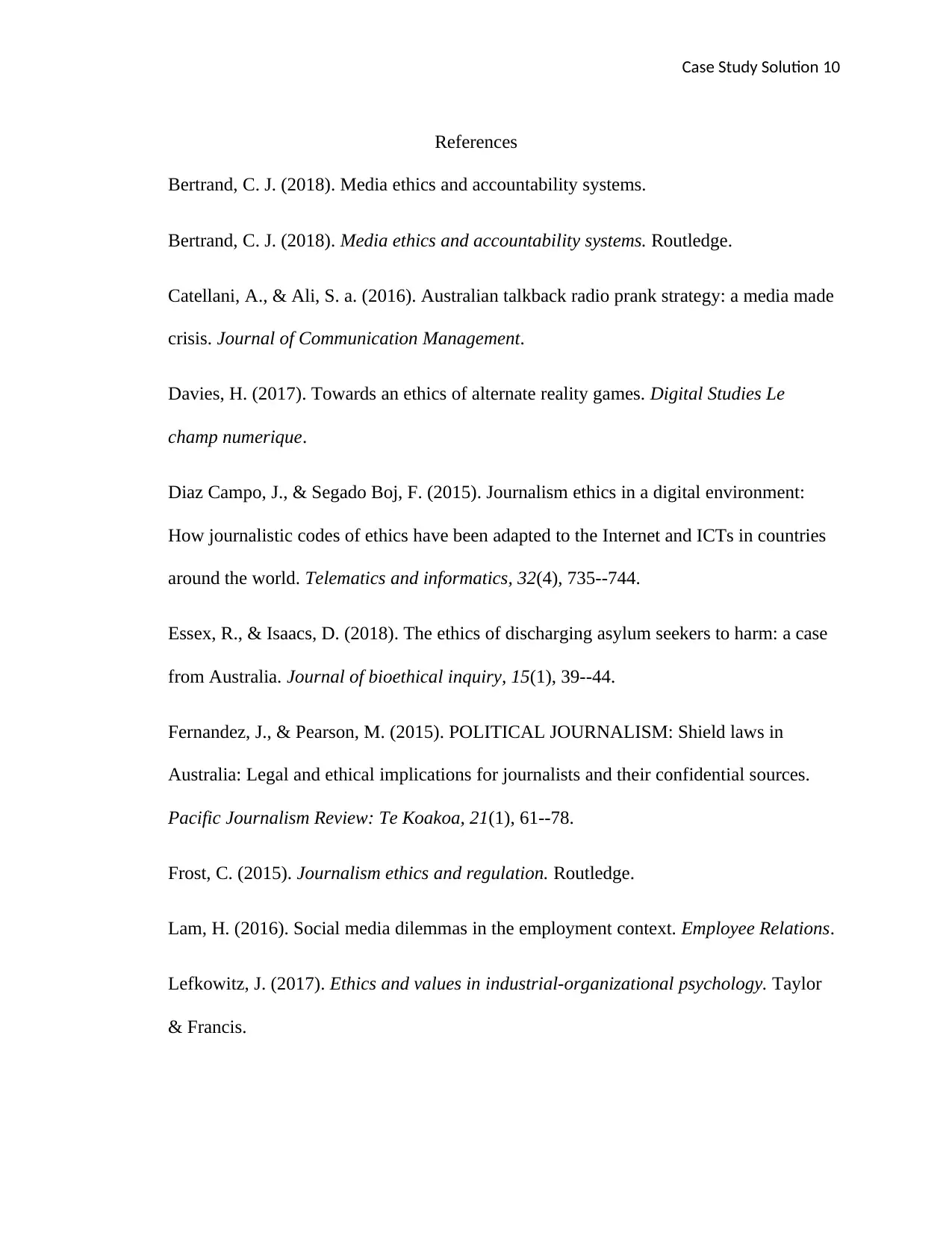
Case Study Solution 10
References
Bertrand, C. J. (2018). Media ethics and accountability systems.
Bertrand, C. J. (2018). Media ethics and accountability systems. Routledge.
Catellani, A., & Ali, S. a. (2016). Australian talkback radio prank strategy: a media made
crisis. Journal of Communication Management.
Davies, H. (2017). Towards an ethics of alternate reality games. Digital Studies Le
champ numerique.
Diaz Campo, J., & Segado Boj, F. (2015). Journalism ethics in a digital environment:
How journalistic codes of ethics have been adapted to the Internet and ICTs in countries
around the world. Telematics and informatics, 32(4), 735--744.
Essex, R., & Isaacs, D. (2018). The ethics of discharging asylum seekers to harm: a case
from Australia. Journal of bioethical inquiry, 15(1), 39--44.
Fernandez, J., & Pearson, M. (2015). POLITICAL JOURNALISM: Shield laws in
Australia: Legal and ethical implications for journalists and their confidential sources.
Pacific Journalism Review: Te Koakoa, 21(1), 61--78.
Frost, C. (2015). Journalism ethics and regulation. Routledge.
Lam, H. (2016). Social media dilemmas in the employment context. Employee Relations.
Lefkowitz, J. (2017). Ethics and values in industrial-organizational psychology. Taylor
& Francis.
References
Bertrand, C. J. (2018). Media ethics and accountability systems.
Bertrand, C. J. (2018). Media ethics and accountability systems. Routledge.
Catellani, A., & Ali, S. a. (2016). Australian talkback radio prank strategy: a media made
crisis. Journal of Communication Management.
Davies, H. (2017). Towards an ethics of alternate reality games. Digital Studies Le
champ numerique.
Diaz Campo, J., & Segado Boj, F. (2015). Journalism ethics in a digital environment:
How journalistic codes of ethics have been adapted to the Internet and ICTs in countries
around the world. Telematics and informatics, 32(4), 735--744.
Essex, R., & Isaacs, D. (2018). The ethics of discharging asylum seekers to harm: a case
from Australia. Journal of bioethical inquiry, 15(1), 39--44.
Fernandez, J., & Pearson, M. (2015). POLITICAL JOURNALISM: Shield laws in
Australia: Legal and ethical implications for journalists and their confidential sources.
Pacific Journalism Review: Te Koakoa, 21(1), 61--78.
Frost, C. (2015). Journalism ethics and regulation. Routledge.
Lam, H. (2016). Social media dilemmas in the employment context. Employee Relations.
Lefkowitz, J. (2017). Ethics and values in industrial-organizational psychology. Taylor
& Francis.
Paraphrase This Document
Need a fresh take? Get an instant paraphrase of this document with our AI Paraphraser
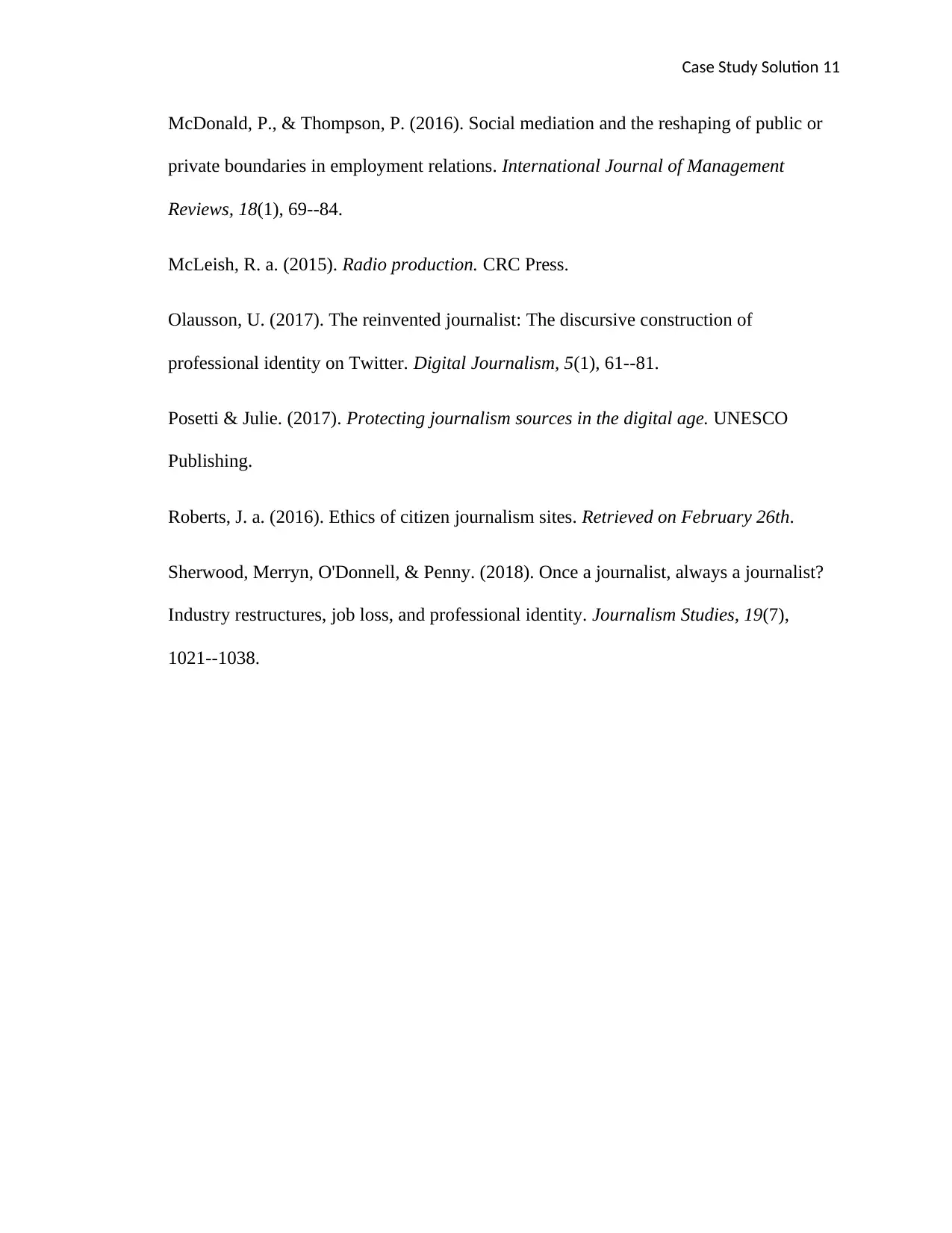
Case Study Solution 11
McDonald, P., & Thompson, P. (2016). Social mediation and the reshaping of public or
private boundaries in employment relations. International Journal of Management
Reviews, 18(1), 69--84.
McLeish, R. a. (2015). Radio production. CRC Press.
Olausson, U. (2017). The reinvented journalist: The discursive construction of
professional identity on Twitter. Digital Journalism, 5(1), 61--81.
Posetti & Julie. (2017). Protecting journalism sources in the digital age. UNESCO
Publishing.
Roberts, J. a. (2016). Ethics of citizen journalism sites. Retrieved on February 26th.
Sherwood, Merryn, O'Donnell, & Penny. (2018). Once a journalist, always a journalist?
Industry restructures, job loss, and professional identity. Journalism Studies, 19(7),
1021--1038.
McDonald, P., & Thompson, P. (2016). Social mediation and the reshaping of public or
private boundaries in employment relations. International Journal of Management
Reviews, 18(1), 69--84.
McLeish, R. a. (2015). Radio production. CRC Press.
Olausson, U. (2017). The reinvented journalist: The discursive construction of
professional identity on Twitter. Digital Journalism, 5(1), 61--81.
Posetti & Julie. (2017). Protecting journalism sources in the digital age. UNESCO
Publishing.
Roberts, J. a. (2016). Ethics of citizen journalism sites. Retrieved on February 26th.
Sherwood, Merryn, O'Donnell, & Penny. (2018). Once a journalist, always a journalist?
Industry restructures, job loss, and professional identity. Journalism Studies, 19(7),
1021--1038.
1 out of 11
Related Documents
Your All-in-One AI-Powered Toolkit for Academic Success.
+13062052269
info@desklib.com
Available 24*7 on WhatsApp / Email
![[object Object]](/_next/static/media/star-bottom.7253800d.svg)
Unlock your academic potential
Copyright © 2020–2025 A2Z Services. All Rights Reserved. Developed and managed by ZUCOL.




